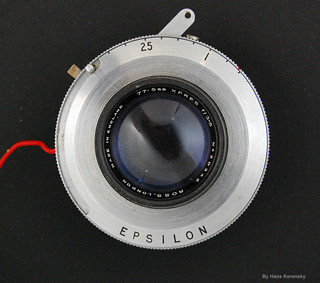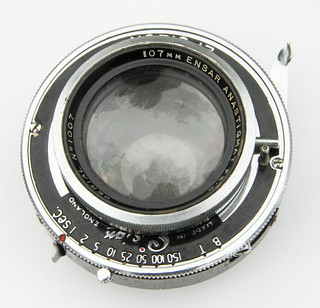Difference between revisions of "Epsilon"
(add image) |
m (removed stub, minor text edits) |
||
| Line 1: | Line 1: | ||
| − | |||
| − | |||
| − | There are some variations of the Epsilon which was gradually improved after it's | + | '''Epsilon shutters''' are rim-set leaf shutters made by [[Houghton and Ensign |Barnet Ensign Ross]] (and the same company under later names) for their own folding cameras, in the late 1940s and 1950s. The same name, usually appearing on the face-plate below the lens, was used for shutters with at least two levels of specification. The shutters have a cable-release socket, but no delayed action. Most are synchronised for flash with a PC socket, however some early versions aren't synchronised and the Kodak Epsilon has a non standard Kodak fitting for a flash cord. Epsilon shutters also appear on some examples of other British makers' cameras (such as the [[Kershaw Curlew]]). [[Kodak Ltd.|Kodak Ltd (UK)]] used the Epsilon shutter for some of their British-made lenses after WWII, most common of which are the 203mm f7.7 Ektar and the 100mm f4.5 Anastar, these shutters are marked Kodak Epsilon. |
| + | |||
| + | There are some variations of the Epsilon which was gradually improved after it's introduction during WWII, there are Epsilon shutters with top speeds of 1/150, 1/200, 1/250, 1/300 and 1/400 | ||
The #0 sized Epsilon shutter is interchangeable with other #0 sized shutters such as the [[Compur]], [[Copal]], [[Seiko]], [[Trikon]] ([[Ross]]), [[Prontor]] SVS and [[Prontor]] Press. | The #0 sized Epsilon shutter is interchangeable with other #0 sized shutters such as the [[Compur]], [[Copal]], [[Seiko]], [[Trikon]] ([[Ross]]), [[Prontor]] SVS and [[Prontor]] Press. | ||
Revision as of 09:06, 21 November 2013
Epsilon shutters are rim-set leaf shutters made by Barnet Ensign Ross (and the same company under later names) for their own folding cameras, in the late 1940s and 1950s. The same name, usually appearing on the face-plate below the lens, was used for shutters with at least two levels of specification. The shutters have a cable-release socket, but no delayed action. Most are synchronised for flash with a PC socket, however some early versions aren't synchronised and the Kodak Epsilon has a non standard Kodak fitting for a flash cord. Epsilon shutters also appear on some examples of other British makers' cameras (such as the Kershaw Curlew). Kodak Ltd (UK) used the Epsilon shutter for some of their British-made lenses after WWII, most common of which are the 203mm f7.7 Ektar and the 100mm f4.5 Anastar, these shutters are marked Kodak Epsilon.
There are some variations of the Epsilon which was gradually improved after it's introduction during WWII, there are Epsilon shutters with top speeds of 1/150, 1/200, 1/250, 1/300 and 1/400
The #0 sized Epsilon shutter is interchangeable with other #0 sized shutters such as the Compur, Copal, Seiko, Trikon (Ross), Prontor SVS and Prontor Press.
|
| ||||
|
|



